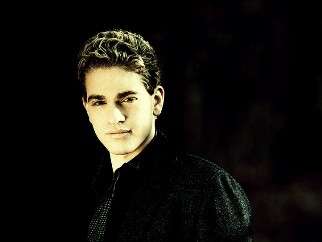|
Back
S’Wonderful? Almost...Sometimes... New York
Frick Collection Concert Hall
12/04/2016 -
Ferruccio Busoni: Chorale Prelude After Bach’s “Nun komm’ der Heiden Heiland”
Joseph Haydn: Fantasia in C Major, Hob. XVII.4
Ludwig van Beethoven: Fifteen Variations and Finale alla Fuga on an Original Theme in E-Flat Major, Op. 35
Max Reger: Träume am Kamin : zwölf kleine Klavierstucke, opus 143
Leopold Godowsky: Symphonic Metamorphosis on Strauss’ “Die Fledermaus”
Joseph Moog (Pianist)

J. Moog (© Thommy Mardo)
Joseph Moog is not a pianist easily intimidated. Most artists under the age of 30 would make their New York debut with programs carefully crafted to impress audiences with the familiar old standards, a short contemporary work and a whiz-bang finale. Outside of that ending (by a composer who is usually looked on with condescension), Mr. Moog broke the other rules.
But this has been the 29-year-old German modus operandi since his concertizing start half a dozen years ago. He has indeed taken on a few familiar pieces, mostly concertos of the Romantics. But he has also, like Marc-André Hamelin, dug out rare composers and rarer music. And that has served him well enough to be elected Musical America’s “Young Artist of the Year.” So his concert this afternoon in the concert hall of the Frick Collection was greatly anticipated.
The recital was a good steady one, very proper concertizing from a conservative well-trained pianist. Yet if one was expecting the Hamelin method of projecting unknown music to the point where we could say, “Why has that piece been ignored all these centuries?”, Mr. Moog was disappointing.
Yet looking around the Frick Collection hall–every seat taken by serious well-dressed concert-goers–it was evident that he was their kind of pianist.
Mr. Moog started with the relatively familiar, the Busoni version of Bach’s “Now Come, Savior of the Heathens”, not exactly a gangbuster beginning. Nor was the performance terribly sacred. It was serious to the point of plodding, the sobriety precluded even an attempt at emotion. Either lulled or mesmerized, the audience didn’t applaud, so Mr. Moog launched into the second work of a chronological program.
This should have been the antidote for the Bach-Busoni gravity, for Haydn’s Fantasia is, to say the least, a jolly piece. It bounces, turns somersaults, and is happily erratic. It also tests the fingers of the best players, and Mr. Moog had no problems with the twists and turns. Alas, bouncy it wasn’t. Joseph Moog obviously enjoyed solving Haydn’s pianistic tricks with a minimum of effort. Yet when performed by less inhibited players, it leaves one with a sense of daring or youthful joy. This, though, was the performance of a mature-sounding artist showing his maturity.
The longest work here was Beethoven’s “Prometheus” (and later “Eroica”) Variations, and again Mr. Moog showed that he was a master on the keyboard. Nothing was idiosyncratic, nothing was out of place. Not a single variation is easy, and Mr. Moog was as exacting as necessary. The final fugue, in fact, was an example of splendid clarity.
Mr. Moog’s love of the unfamiliar came out with a work with which I was entirely unfamiliar. Max Reger’s variations (one of which was listed in a Bangkok program as Variations on a Merry Theme by Hitler) are wonderful, as are his massive orchestral pieces. But Fireside Dreams: 12 Short Pieces is never played here, and the pianist thus gave a short introductory talk.
The dozen bagatelles were delicious to hear, with certain reservations. The first three were 100 percent Brahms. The final one was 100 percent Chopin’s Berceuse. The others overlapped with Schumann, with little of Reger. That they were written in 1915 (the year before he died from a crash diet) seemed anachronistic, if not unlikely. Joseph Moog, though, played them with great care, with obvious adoration. The brevity, the thought–and the possible conscious imitation of other composers–made them well worth hearing.
The final work was by Leopold Godowsky. When I once told a pianist that I loved Godowsky’s version of Chopin’s Etudes, he glared at me as though I said I’d voted for Trump. But the great technician did have fun with his improvisations.
And nobody would object to Godowsky’s version of Fledermaus. Also, this was Joseph Moog at his very best. No, he never exaggerated Godowsky’s excesses. Instead, by keeping them in check, he allowed the brilliance to shine out. If not polytonal, Godowsky dared the pianist to play two...or three...or a whole quodlibet of tunes, and this is where Mr. Moog showed what splendid technique he had.
One should have left it with such a crystalline performance. But for an encore, he played his jazz version of Gershwin’s S’Wonderful. The jazz was more cocktail-bar 1950’s style, lacking Ella’s sensuosity, Tatum’s impossible fingers or–my favorite version–the Hepburn/Astaire duet. Yet I don’t hold that against young Joseph Moog. He has his own talents, personality and skill, and hopefully he will find exactly the kind of music where he can feel his artistic gratification.
Harry Rolnick
|